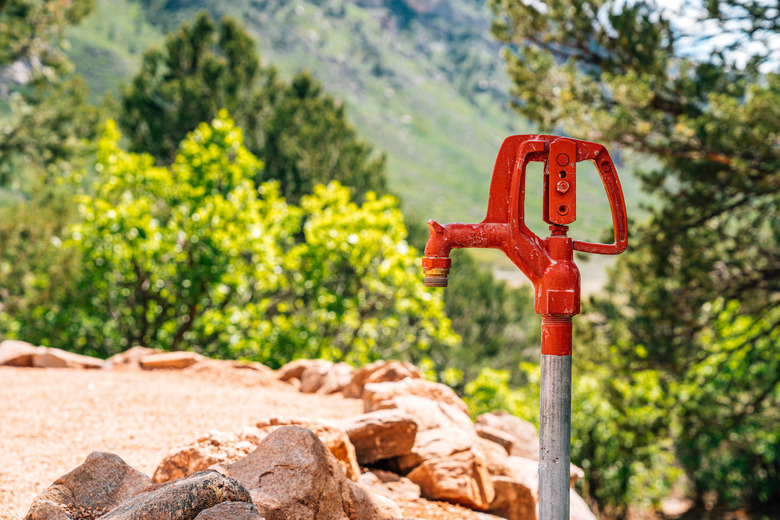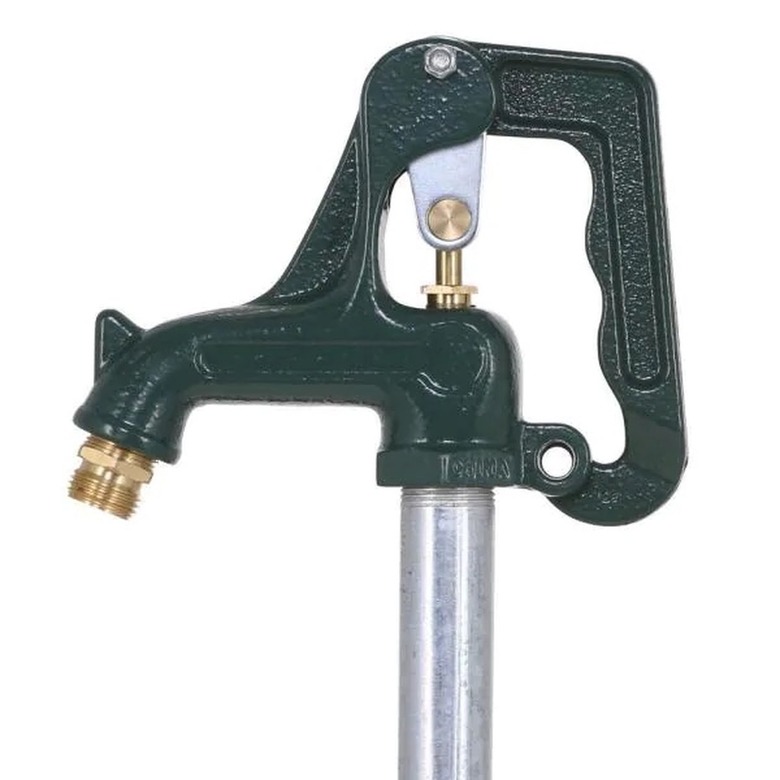What Is A Yard Hydrant And How Does It Work?
We may receive a commission on purchases made from links.
Essentially an external faucet, a yard hydrant brings cold-water service to areas that are too far away to reach with a hose connected to a house spigot. You may not have heard the term before, but you've undoubtedly seen yard hydrants at campgrounds and in parks.
Often called water pumps, yard hydrants have a clever design that allows them to drain automatically to prevent freezing in winter, similar to frostproof sillcocks on a house. They are very helpful when they are properly installed, but they are potentially problematic when they aren't. Installing the hydrant and supply line at the proper depth is key to a long and useful life.
Tip
Looking like old-fashioned outdoor water pumps, yard hydrants are frostproof spigots that provide water in the yard or garden.
How Yard Hydrants Work
How Yard Hydrants Work
A yard hydrant consists of a pumplike metal faucet head connected to a long, metal standpipe that extends deep into the ground. A cold-water pipe runs horizontally in a trench from a source (such as a home's water supply piping inside the house) to the base of the hydrant's standpipe. The hydrant's handle controls an operating rod that runs through the standpipe and has a rubber plunger at its bottom end. The plunger fits into a valve seat, much like the valve on a compression-style faucet.
Lifting the hydrant's handle raises the plunger, allowing water to flow up the standpipe and out through the faucet spout. Lowering the handle stops the flow of water up the standpipe. When the plunger is in the closed position, a drain port is open, allowing the remaining water in the standpipe to drain into a bank of gravel (installed along with the hydrant) and then into the surrounding soil. This prevents the water from freezing inside the standpipe.
The standpipe drains automatically by force of gravity. As the water drains, it draws in air through the hydrant's spout. This is why it's important to remove a hose connected to the spout when freezing temperatures are expected. Leaving a hose connected prevents air from entering the spout, which in turn prevents the hydrant from draining, and this can lead to a frozen standpipe.
The key to ensuring a frost proof yard hydrant is the standpipe depth. It must be buried below the frost line, where the ground stays unfrozen throughout the year.
Installing a Yard Hydrant
Installing a Yard Hydrant
You can install a yard hydrant yourself, but it requires a lot of digging and hard work, and you don't want to discover a leak after burying your water line. Always remember to turn the water back on and look for problem areas before backfilling the trench you dug for the water supply line. If you're not super confident when it comes to plumbing or you hate digging, it's best to hire a plumber to install your yard hydrant for you.
When installing a yard hydrant, the first thing you need is a water supply, which can be sourced from a well system or city water supply from a home. The water line must be frost-protected from the source to the hydrant and is thus installed in a trench that extends below the frost line.
The frost line is the depth to which the ground freezes where you live, and it's different everywhere. The frost line in Pennsylvania, for instance, is 36 inches. In parts of northern Montana, however, it's 72 inches. There are countless frost line guides on the internet that allow you to search for your frost line depth by entering your ZIP code. Even if you think you know where the line is in your area, it's a good idea to double-check.
Use proper piping when running your water line as well. PVC can break, and metal pipes can rust. It's best to use potable-grade polyethylene ("poly") pipe when running underground water lines. The estimated life of poly pipe is 50 to 100 years, so you won't have to worry about digging up and fixing the water supply line for the foreseeable future. With the right tools, a pro can install poly pipe using a trenchless method that eliminates the need for digging.
Keep in mind that yard hydrant installation is typically governed by the state or local plumbing code. The local building authority will give you all the details you need to add a code-compliant hydrant. You will also likely need a permit for the project.
Why Use a Yard Hydrant?
Why Use a Yard Hydrant?
Yard hydrants provide a very convenient source of water in places where you may lack easy access. Farmers often use them to water livestock and provide water to fields and holding pens more easily. They're also convenient in large gardens or lawns that need routine watering. Some homeowners install yard hydrants next to their driveway for easier car washing. A well-placed hydrant also eliminates the need for lugging a garden hose a long way, and it prevents the need to cover large expanses by joining multiple hoses together, which often causes leaks. Although you may not have given any thought to yard hydrants in the past, you may find yourself wondering how you lived without one once it's installed.
Yard Hydrant Maintenance
Yard Hydrant Maintenance
Fortunately, yard hydrants rarely require much attention, but there are a few issues that can crop up. It's of note that most issues with these hydrants stem from the fact that they weren't buried deeply enough or they aren't able to drain properly. Taking your time and getting the installation right can save you problems later. Even so, you could have some minor problems.
If your hydrant won't shut off all the way, you need to adjust the position of the valve plunger. With most hydrants, you can do this by loosening a setscrew that connects the handle to the operating rod. Then, you adjust the handle position (this varies by model) and retighten the setscrew. The object is to make the rod — and thus the plunger — move farther down to seal against the valve seat.
If your hydrant leaks, tightening the brass packing nut will usually do the trick. If necessary, you can even replace the entire hydrant head. A yard hydrant is a fairly simple device, so you can probably troubleshoot and fix most of these issues yourself if you're handy. There's no shame in calling a plumber if you're not.
Yard Hydrant Tips
Yard Hydrant Tips
Convenience is usually the primary concern when placing a yard hydrant, but location matters too. If you'll use the hydrant during cold weather, try to position it in a wind-protected area with southern exposure, ideally close to a south-facing wall in order to keep things as warm as possible. It's also a good idea to run a few more gallons of water than you need during cold weather. Even if it feels cold to the touch, the running water from your spigot will be significantly warmer than the standpipe on your hydrant. Running more water warms up the pipe a bit so the water in the pipe has ample time to drain instead of freezing.
Although a yard hydrant can last many years, at some point in time, you may need to replace it. This is much easier to do if you install a yard hydrant assist kit when you install your original hydrant. The kit is essentially a sleeve into which the standpipe slides. This offers it a bit more protection than a hydrant has when installed with direct soil contact. If and when you need to install a new hydrant, the assist kit makes it easy to replace the old standpipe without digging.
Do you live in a neighborhood full of pranksters or vandals? You can keep them off your hydrant by slipping a padlock into the holes at the end of the hydrant handle. This prevents anyone from opening the hydrant spigot.
References
- Charles + Hudson: Check the Frost Line by ZIP Code Before Digging Footings
- Boshart Industries: How Yard Hydrants Work and Common Uses
- Barnyards & Backyards: Installing Water Hydrants Can Enhance Property, Make Life MUCH Easier
- Wisconsin Department of Natural Resources: Yard Hydrants
- Boshart Industries: How to Adjust and Repair a Boshart Yard Hydrant
- Seppmann Enterprises: Yard Hydrant Basics: Things You Should Know
- My Farm Life: Let It Flow: How to Install a Frost-Free Water Hydrant
- Charter Plastics: Advantages of Polyethylene Pipe

